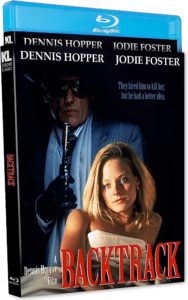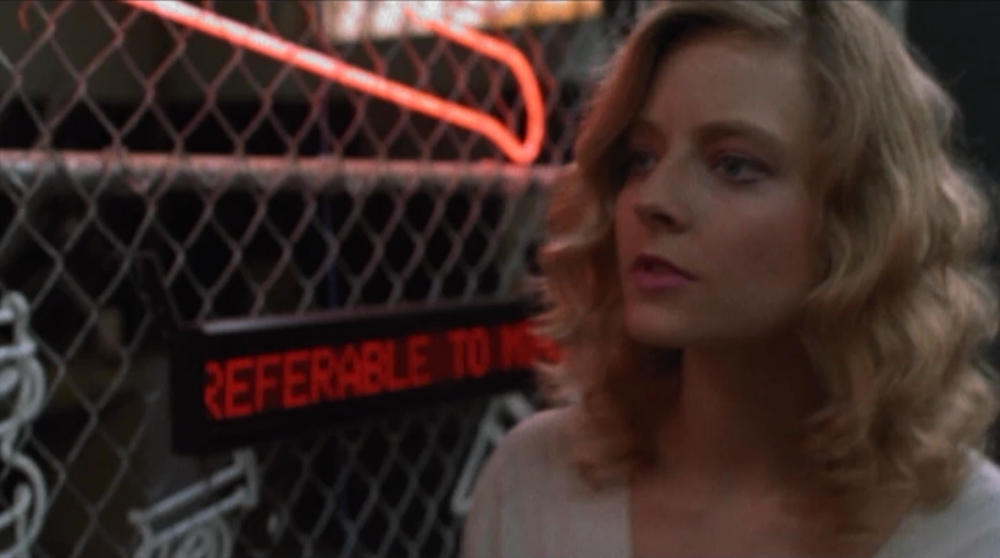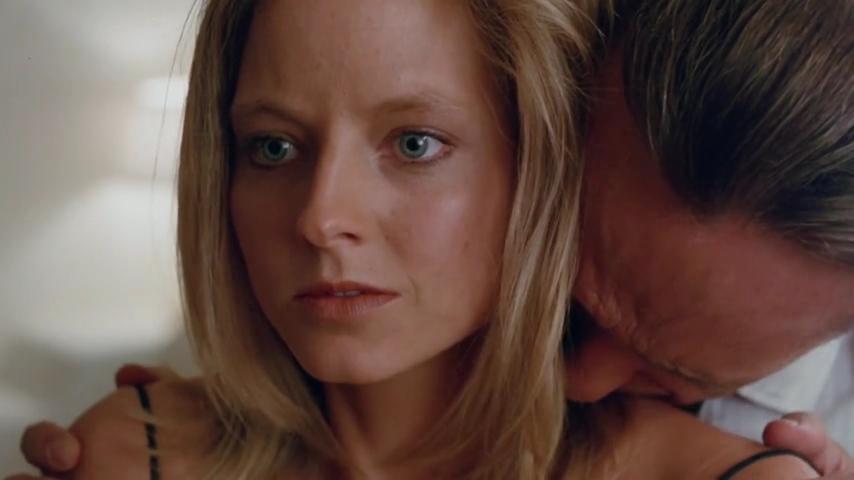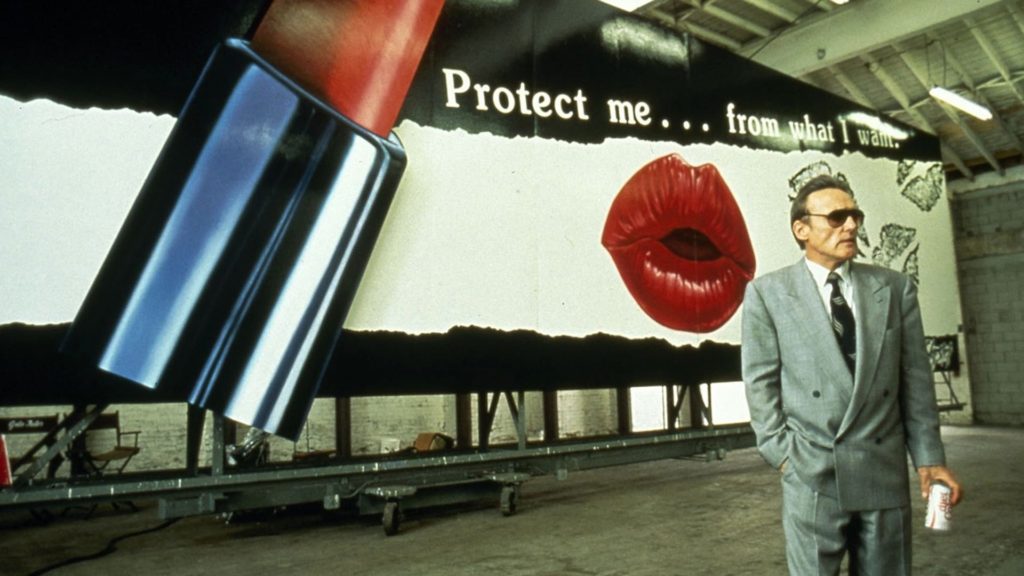Jodie Foster and Dennis Hopper Ignite the Screen in Ridiculous Neo-Noir
DIRECTED BY DENNIS HOPPER/1990
BLU-RAY STREET DATE: APRIL 25, 2023

Reportedly clean, sober, and carrying a Republican Party card in his wallet (much to the chagrin of the screenwriters who provide audio commentary for this new Blu-ray release), Dennis Hopper’s return to the director’s chair had a distinctly heightened mainstream veneer than the countercultural kickstarters of decades gone by that he’d been known for helming (Easy Rider; The Last Movie). The choice word in there being “veneer.” When it comes right down to it, his films of this era (the late ‘80s/early ‘90s) bore unhinged indulges all their own. The difference is that we can readily identify The Hot Spot and Backtrack as neo-noir thrillers- a niche (darn near being its own genre) of stylish and sexy movies that were then quite common in the wild. You don’t even need to see them to know. A quick look at their posters lay out the story. (Like a good poster should).
Overpopulated by half, Backtrack (the title of the 116-minute director’s cut of the 100-minute “Alan Smithee” version you may remember as “Catchfire”) features a murderer’s row of murderers, fed-up cops, artistes, and weirdos. I for one wouldn’t have it any other way. Besides Hopper and Jodie Foster out front, there’s Dean Stockwell (who’s hilarious), Joe Pesci (who’s terrifying), John Turturro (who’s just odd), Fred Ward (who’s a cop, again), Catherine Keener (who’s a truck driver), Charlie Sheen (who’s Anne’s soon-forgotten boyfriend), Alex Cox (who’s on a book cover as D.H. Lawrence), Bob Dylan (who’s a chainsaw artist), Toni Basil (I’m honestly not sure who she is in this), and major monster movie icons Julia Adams and Vincent Price! Is this what Dennis Hopper’s Rolodex looked like?

With 20/20 hindsight it can be stated that the central casting of Jodie Foster in this film is at least two parts incongruous, one part irresistibly fascinating. Pre-The Silence of the Lambs (but just barely), Foster channels a certain bygone smolderingly ingenue sexiness that is, coming from her, frankly kinda weird. Portraying a successful gallery artist of digital media named Anne Benton, a character inspired by artist/photographer Cindy Sherman and neo-conceptual artist Jenny Holzer, the actress is on hand for her own immediately obvious intelligence. But also, her looks. There’s an active performative smolder going on in her, and it’s undeniable. On the lamb after witnessing a mob killing, Benton spends the first third of Backtrack advancing on the run in one stunning disguise after another. And darned if Foster doesn’t pull them all off. But she’d better if she’s going to survive the never-ending dispatches of hitmen on her tail.
Playing “the girl” in a man’s movie has never been Foster’s forte, even when she was a girl. There’s no question that Benton is the most astute, most potent intellectual human barnburner in this thing. She’ll fight and flee and fire weapons if necessary and with every fiber of her being to maintain her agency, not to mention her life. But at the end of the day, we cannot forget that this is a Dennis Hopper film. So, she’s also modeling some lingerie. Like I said, kinda weird. Rather icky.
Hopper stars in as well as directs this rolling ball of fire, and it’s never not his show. Hopper loves contemporary and classically lucid art, so the movie is full of talk of Anne Benton’s controversial LED installations and the occasional Heironymus Bosch imagery. Hopper loves jazz, so the movie itself oscillates from one thing to another with freeform abandon. (His character even plays the saxophone. Hokey, every time. Let’s just say that he’s no Harry Caul). Hopper loves the ladies, so Foster is banged straight by him (ala Pussy Galore) and has a gratuitous shower scene. (Which she reportedly never forgave him for including every frame of possible said footage when he’d apparently told her that it’d be restrained).

Playing a meticulous and obsessive assassin simply called Milo, it’s only a matter of time before he catches Benton. From there, the movie becomes about their relationship. The captor and the captured. The practical and the cerebral. The hot-lead king and the independent woman who finds her own light-emitting diode. The rapist and the victim? (Worn down by his infatuation, she goes to bed with him [off screen] while she’s still his unwilling prisoner). And let’s not forget Clyde and Bonnie. Yes, by the final act, Anne and Milo are a cool criminal couple on the run.
This new KL Studio Classics Blu-ray features a new audio commentary by filmmaker Alex Cox and his significant other, actress/screenwriter Tod Davies. I must say that being on mic with Davies must really bring out the spunk in Cox, as his solo commentaries tend to be hushed and rather deliberate in tone. Here, the Sid & Nancy and Straight to Hell director is considerably more animated and off the cuff, almost to the point that I had to check if it was that Alex Cox.
Anyhow, Cox and Davies are on hand because they were in fact the major screenwriters of this movie, though uncredited. They make mention of a forty-five-minute subplot featuring musician Neil Young which got filmed but didn’t pan out. Not a second of that is in either version of the movie. To hear them tell it, the editors had to put ‘ol Neil down because, as far as being an actor goes, he’s a really great singer/songwriter. If this is in fact true, it would’ve been cool to have at least a few of Neil Young’s scenes in the Blu-ray extras, but alas, nope. Someone decided the film doesn’t need him around, anyhow. Is there any truth to any of that whatsoever? Sure beats me. (The internet is little help, go figure). I might be encouraging some very weird rumors, the kind that can only seem plausible in the context of a project like this.

Now then, if you’ve seen the shorter theatrical cut, Catchfire, in the past, you may be wondering how this review is anything more than an outright panning of this whole endeavor. KL Studio Classics has done its due diligence by including both cuts on its single-disc release. While the longer, director approved Backtrack version is rightfully the main attraction, the sad reality seems to be that the rest of the world knows this film only in its “Catchfire” form. (As evidenced in its IMDb and Letterboxd entries). This despite the comparable fact that Catchfire and Backtrack are almost two different movies. Most accurately, the former is an embarrassingly hackneyed mutilation of the latter. While both cuts have decent transfers and audio quality, only the director’s cut doesn’t thoroughly fall apart in its midpoint. Not only does Catchfire suffer sixteen minutes less malarkey, it actively features some different malarkey not seen in the longer Backtrack. If you want to see Jodie Foster’s character inexplicably and immediately shift from repulsed to in love with Hopper’s character, the theatrical cut is the one for you.
Really though, this disc provides a case study in the power of film editing. While neither version is inept in terms of baseline timing of the splices and whatnot, the story and characterizations suffer tremendously when cut and shuffled. And yes, Hopper’s crackpot dolings and shoehornings of his own indulgences also suffer in Catchfire as the project sinks in generic late-‘80s direct-to-video-level action movie quicksand. If any of this scattershot execution sounds hits your targets, now is your chance to track back and catch this chemical fire in a righteously contained form.


